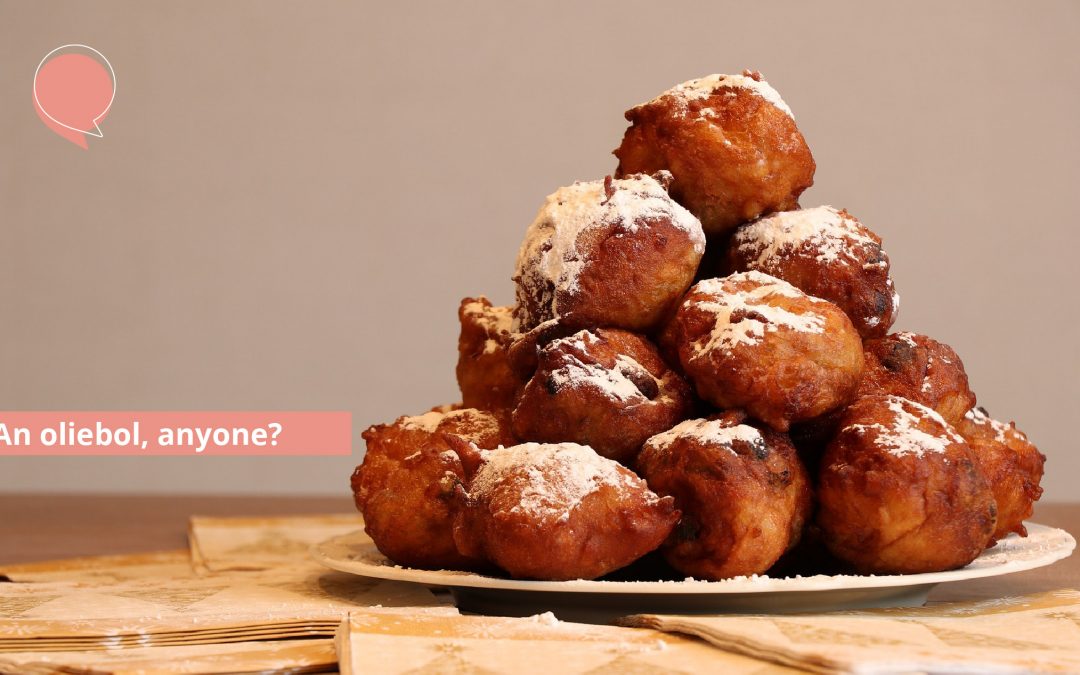
An oliebol, anyone?
December 2022 | Written by – Willem van Hoorn
Among other things, the month of December will be marked by the winter solstice, at least in the Northern hemisphere. After that moment the days here will slowly get longer again. And that is another way of saying that, at this northern latitude, they are currently quite short. Not coincidentally, the month of December comes with several indoor festivities, most notably the celebration of Christmas and New Year’s Eve.
Of old, people here would spend most of their time indoors, this time of the year. Most work in the fields was done, the harvest of the past summer was processed and stored, the cattle would be in the stable, and the trees had shed their leaves. Plant-life withdrew in the ground, awaiting the coming of a new spring, and people, as far as their work allowed, withdrew inside their houses. Those houses would be lit, by means of candles, kerosene lamps or grease pots with a wick in them. Anything to chase away the darkness.
Many historians believe that, when Christianity settled in northern Europe, they decided to let one of its main celebrations, Christmas, take place in late December. Not so much because of any ‘real’ historical date, but because that coincided seamlessly with the ‘Yule’ traditions of the Germanic tribes that lived here, during which they celebrated the coming return of the sunlight. The idea: leave the existing rituals in place, just change the theme. You’ll meet much less resistance that way.
Speaking of ‘rituals’: since as long as people can remember, the Dutch have a ritual that accompanies the celebration of New Year’s Eve: the making and eating of the so-called ‘oliebollen’. The literal translation of oliebollen, oil balls, sounds kind of gross, but I’m quite happy with the translations that are used most of the time: ‘Dutch donuts’ or ‘Dutch dumplings’.
Oliebollen are made by scooping-up a certain amount of dough and dropping that into a pan or a deep fryer filled with hot oil (traditionally hot lard). In this way, a sphere-shaped oliebol emerges. Oliebollen are usually served with powdered sugar. As said: they are part of the traditional Dutch New Year’s Eve celebration. Other than that, they are sold at festivals and markets, but always in wintertime.
The tradition goes back at least centuries. According to some even to ancient Germanic times. The earliest discovered recipe of oliekoecken (“oil cookies”, the direct precursor of the oliebol) came from the 1667 edition of the Dutch book ‘De verstandige kock, of sorghvuldige huyshoudster’ (the sensible cook or careful housekeeper), a bestselling recipe book in the Netherlands during the 17th century. And one of the oldest known depictions of oliebollen is a painting by Aelbert Cuyp, from around 1652, ‘Young woman with cooking pot filled with oliebollen’.

Should you want to ‘go all the way’, and make your own oliebollen, the Internet will be more than happy to provide you with a good recipe. See for example this one. Personally, I prefer my oliebollen with raisins inside, but recipes for both varieties (with and without raisins, and sometimes other additions) are available. Some recipes will (correctly) inform that oliebollen are often accompanied by the so called ‘appelbeignets‘.
Should you find this too much work (or too much smell in the house!), in the period between Christmas and New Year’s Eve almost every bakery in town will be most happy to sell you good quality oliebollen, with the powdered sugar and all. And if you don’t want to wait that long, usually from late November you can find the so-called ‘oliebollenkraam’ at different places in town and on the weekly markets. The Dutch word ‘marktkraam’ means: ‘a market stand’. But the oliebollenkraam usually is a bigger truck, with all the equipment inside to make and sell oliebollen in large quantities.
And this completes my blog post for this month. I wholeheartedly invite you to enjoy this old Dutch wintertime tradition, and have some oliebollen, in the weeks to come. And moreover, I already wish you and yours a wonderful holiday season!

Willem van Hoorn
He works as a Policy Advisor Internationalization at Eindhoven University of Technology. He has been leading several projects and initiatives in the Brainport region to achieve integration and internationalization. When he’s not reading or writing, Willem is often brainstorming for innovative ideas, connecting with others, or bicycling towards the coast.
He is an exceptional Dutch Culture Expert and Storyteller!
To comment on this post or anything else you have seen on Expat Spouses Initiative page, please message us on Facebook or email us.

We Are Not Alone Campaign, is presented in collaboration with Expat Spouses Initiative – Eindhoven, LIVING IN, Holland Expat Center & Brainport Eindhoven. Through this campaign, we aim to bring the International community together and engage them actively.
In collaboration with


